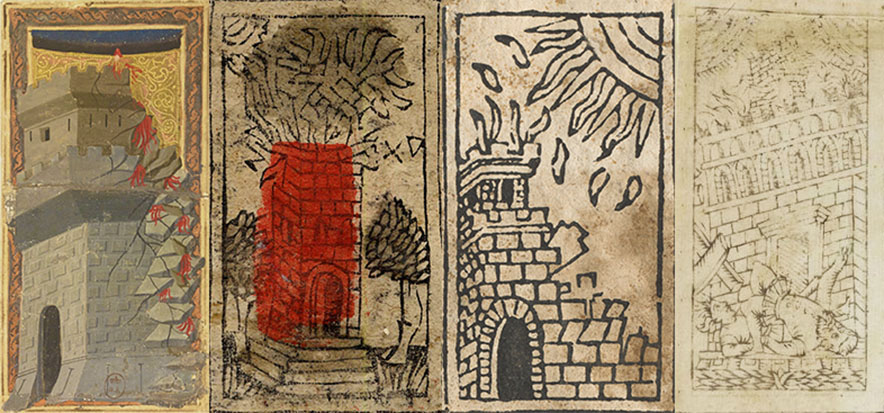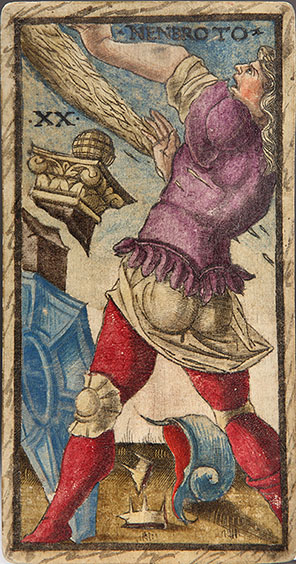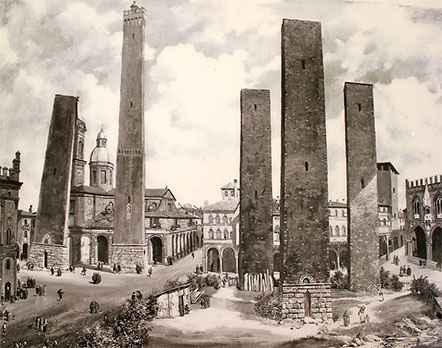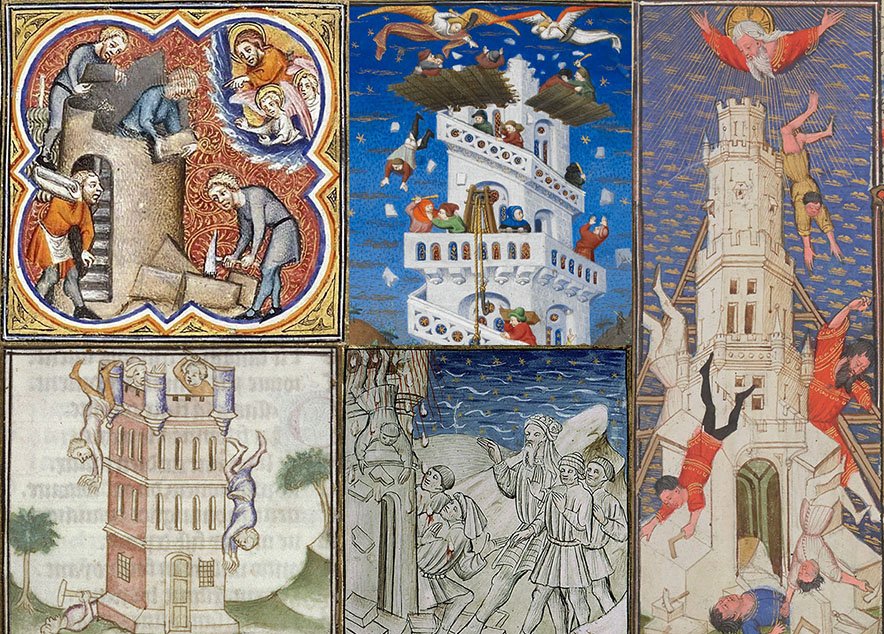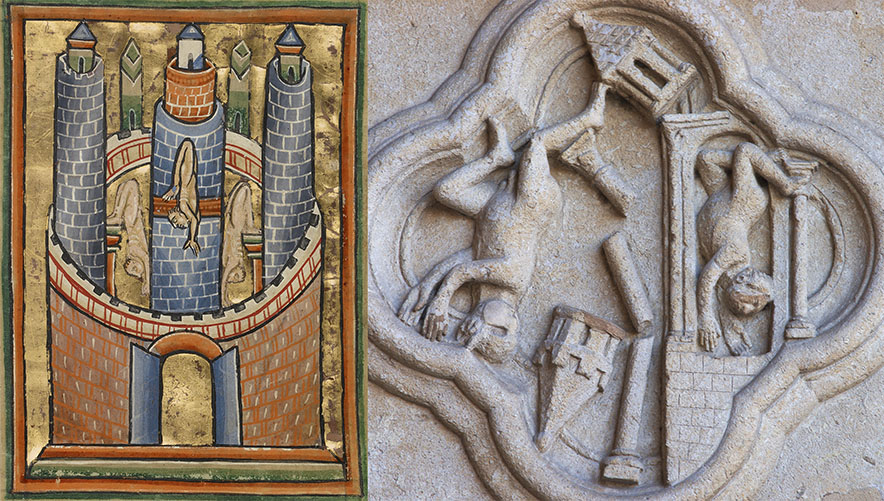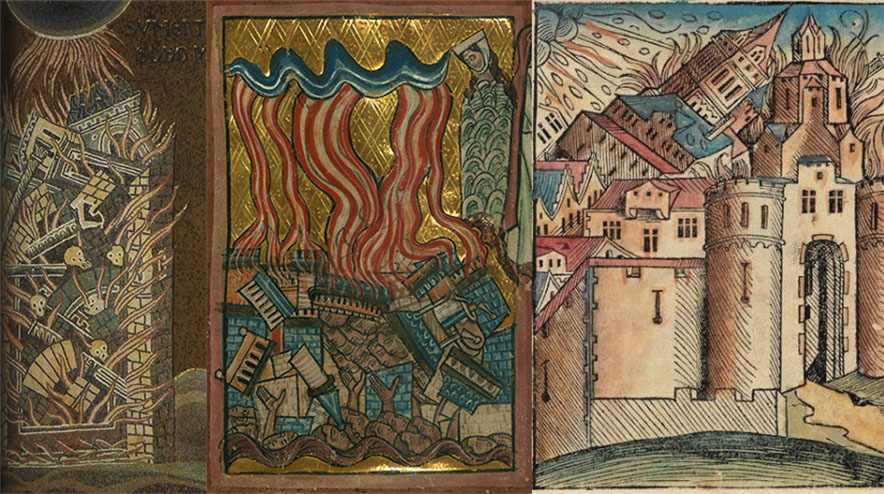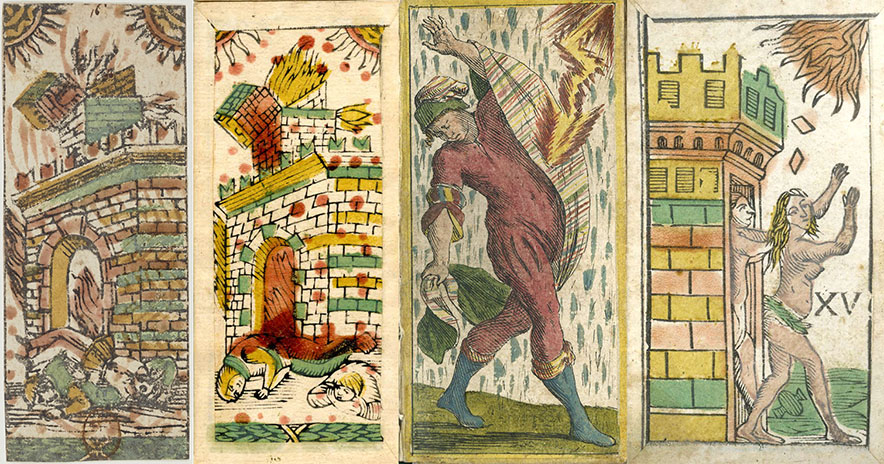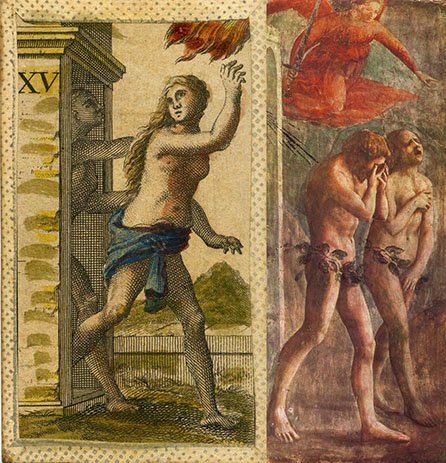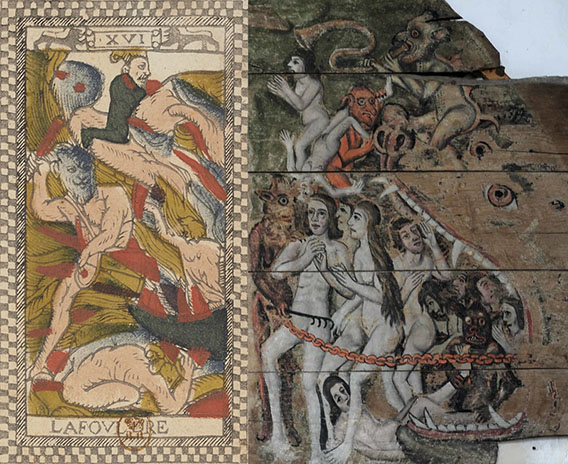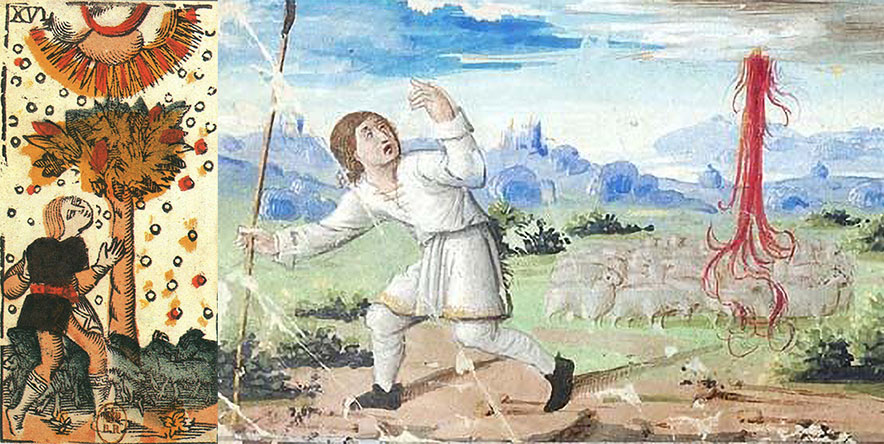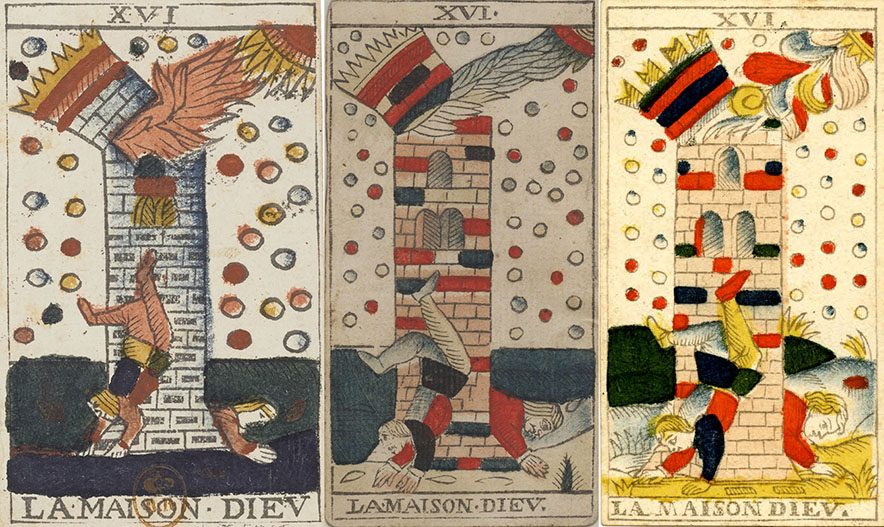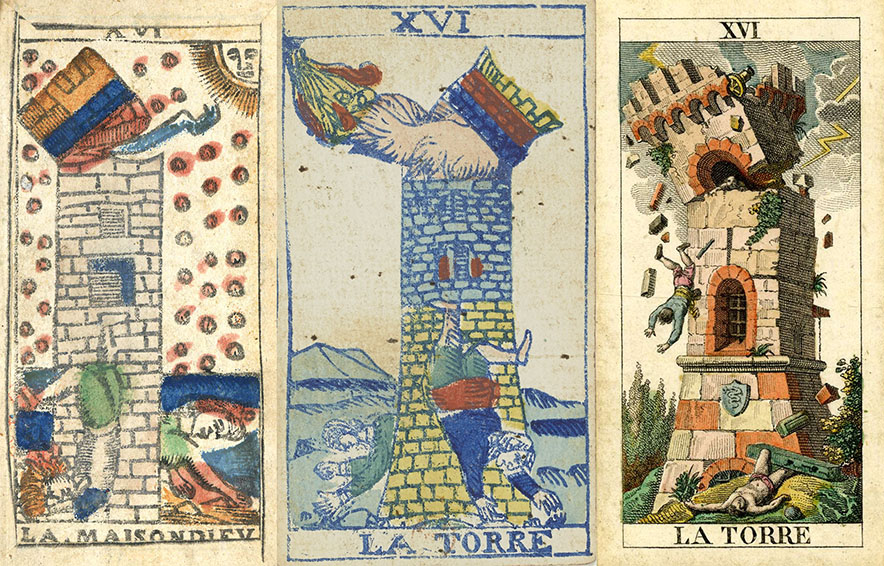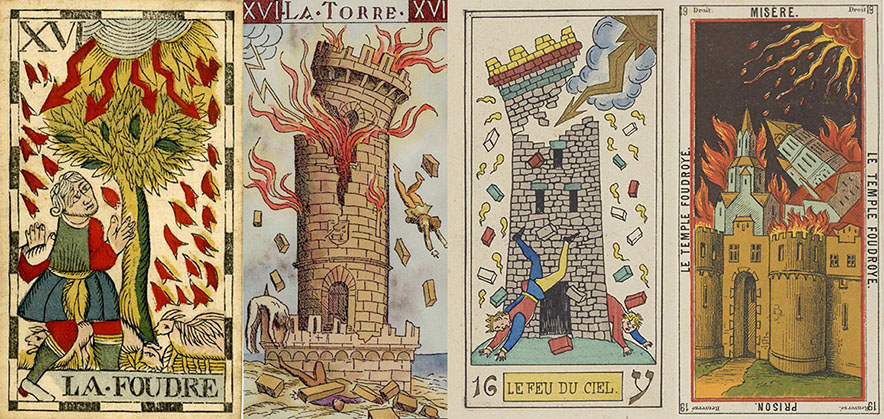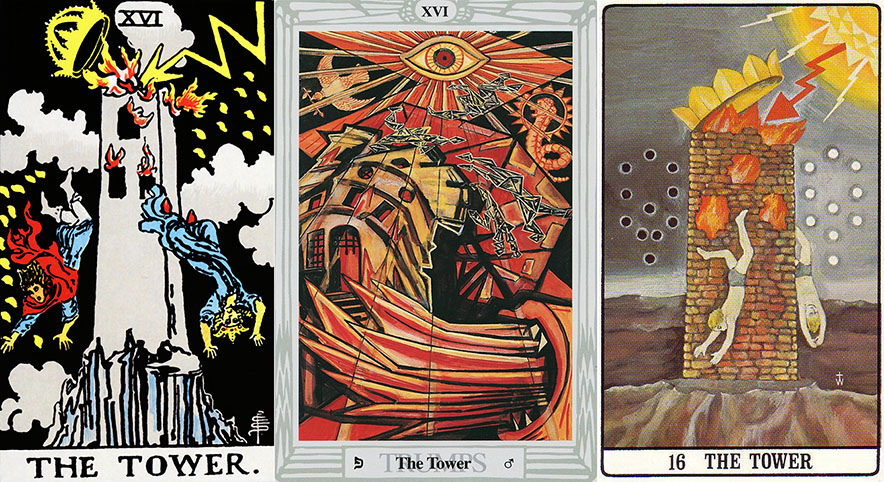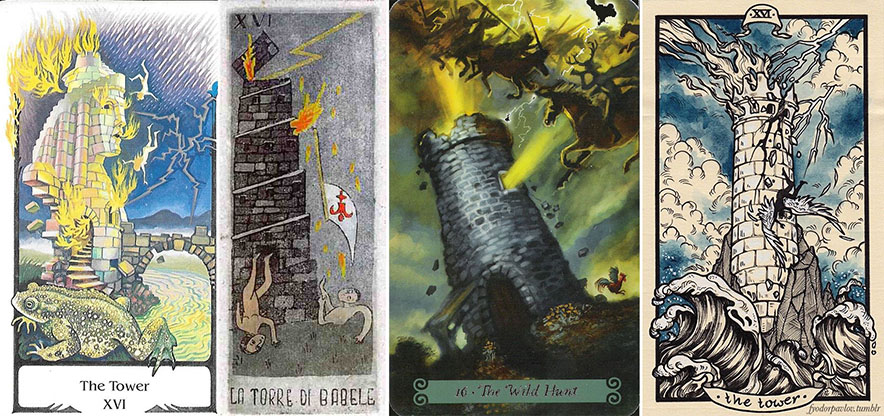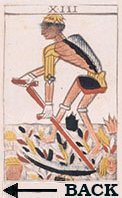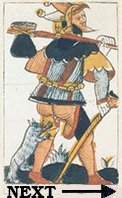THE TAROT WHEEL
LA SAGITTA - THE ARROW
To start our journey through time with La Sagitta, the Arrow card, today called the Tower, I begin with a 15th Century Bulgarian manuscript showing the construction and destruction of the Tower of Babel. The Tower of Babel (Babylon) is often associated with La Sagitta. In fact this card stands for purification, a lightning bolt send by God to Earth to punish and purify sinners on Earth. This card is associated with the anger of God for all the bad things that people are doing on Earth against the clear instructions the Lord has given. In the Bible there are many passages that could be associated with the anger of God. Exemples are the Tower of Babel, the destruction of Sodom, the fall of the Idols and the purification during the Apocalypse. But the list is much longer, and some examples will be shown later on this page. A popular association of the card is, although the Bible does not speak about its destruction, with the Tower of Babel, probably the reason why the card is often called the Tower. There are not a lot of cards that bear so many names as this one, the arrow, lightning, the tower, the God house (la maison Dieu), a clear sign that the real significance of this card, the anger of God, posed a lot of problems to card makers during time. Here below four card images that came to us through time, all the way down from the 15th Century, one handpainted card and three printed images that are part of abandonned sheets containing several cards at once:
All four cards show a building being destroyed. The first card on the left is the only handpainted card we have illustrating La Sagita. In this case the arrow is a red flame of fire descending from heaven on top of the building. At the right side of the image the building is crumbling down. The card is from the so called Charles VI deck that was probably painted for the Duke of Este somewhere between 1460 and 1475 and is conserved in the French National Library. The three following cards are probably made after 1475, maybe around 1500 or very short after this date. The second card is from one of the Budapest sheets, conserved in the Budapest Museum of fine arts. The museum has two copies of this sheet, the second sheet is identical apart from some details in the coloring. We see a tower surrounded by trees. On the top left side of the image the Sun, that is apparently putting the top of the tower in flames. The sheet has probably been made in the Ferrare area. The third image is from the so called Rosenwald sheet. This sheet is conserved in the National gallery of arts in Washington D.C. Again the Sun is putting the image on fire, this time from the right side. This printed image is almost identical to the much more elaborated Charles VI card. The card is believed to have its origins in Bologna or Florence. The last card is from the Rothschild collection conserved in the French Louvre museum. It is the oldest representation of a Tarocchino deck we have and it was produced in Bologna. Here on top two suns attacking the building that is in flames. Two people are falling down, just as on the illustration of the tower of Babel on top of this page. We remark again that all images represent a high building beying destroyed by fire coming from heaven.
At the end of the 15th Century, in the year 1493, a new Tarot deck was created. Actually we call this deck the Sola Busca deck, named to the last family that owned a complete hand colored version of this deck. The family sold the deck to the Italian State who send the deck to the Pinacoteca di Brera in Milan, where the deck is actually conserved. Thirty-five non painted cards are conserved spread out over several musea in Europe and the States. The Sola Busca deck was a very revolutionary deck that broke with the existing Tarot traditions. On the trump cards we see images of ancient heros and all pip cards are illustrated. Several of these pip cards have been used as a model for the famous Waite Smith Tarot deck. Concerning the trump cards, it is very difficult to associate the Sola Busca trumps to the standard imagery because this deck did not respect the images nor the numbering. One of the images that could clearly be associated with a Tarot trump is the image here at right, with a hero called Nembroto and numbered XX. Nembroto is struck by lightning and a nearby pillar is decapitated. Nembroto could be identified as Nemrod (Nimrod), King of Babel during the construction of the tower. In the Bible in the book of Genesis, Nimrod is presented as a great-grandson of Noah. Hereunder the concerned verses 1, 6, 8 and 10 of Genesis chapter 10:
6 And the sons of Ham; Cush, and Mizraim, and Phut, and Canaan.
8 And Cush begat Nimrod: he began to be a mighty one in the earth.
So the card XX Nembroto of the Sola Busca deck refers clearly to the Tower of Babel and as such can be associated to card XVI of the standard Tarot trumps, the Tower.
The card was originally called La Sagitta, referencing to lightning. Still on all ancient cards we see towers being destroyed. Why? What was the relation between the ancient Italians and towers? Most people think of towers as defense structures belonging to a castle or a city wall or as bell towers, attached to a church or an important public building. In ancient Italian city states, especially in and around Tuscany, a tower was much more. It was a status symbol displaying the wealth of a family. In the 12th and 13th century most cities had a forest of towers, many of them around 60 to 70 meters (200 to 230 feet) high. Florence had over 150 towers, Bologna almost 100 and other cities like Sienne were just as well known for their towers. Most of the towers were destroyed. On the left we see an old drawing of the city center of Bologna. The three towers at the right have been destroyed around 1918 to make place for great urbanization plans, the two at the left became well known symbols for the city of Bologna.
The highest tower, called Torre degli Asinelli, is 97.2 meters (319 feet) high, has been constructed between 1109 and 1119 and is one of the highest masonry towers in the world. Both towers are leaning, although not as much as the Campanila (bell tower) in Pisa. The most beautifull of these towers, remnants of this medieval period, can be seen (and sometimes visited) in Bologna and San Gimignano (beware, the Asinelli tower has a wooded staircase with 498 steps constructed in the 17th Century). It is during the 13th (Florence) and 14th (other city states) Century that rich families stopped building unconfortable tower houses in favor of richly decorated palaces. Still towers stayed prestigious objects and it is easy to understand why the destruction of a tower was associated by the 15th Century Italians living in a City State with a punishment of God.
The question is now, how was Gods anger represented in Medieval and early Renaissance art? This is much less straightforward than the preceding page of the Devil. Let us first present some images and then discuss them, starting with some images of the Tower of Babel.
Most medieval and early Renaissance images of the Tower of Babel are showing the tower in construction. I will show only one of them as a reference, because when the Tarot portrays the Tower of Babel, it portrays the Tower after the Confusion of Tongues, also called the Fall of Language, took place. The first image top left is made by a French illuminator called Guiard des Moulins in 1371. It is a very typical representation showing the Tower with God and his angels warning the people of Babel to stop this project. In fact, the construction of the Tower of Babel had no intention to glorify the Lord. Its intention was to defy God, to reach the heavens and as such to glorify its builders. To punish the people, God gave them different languages, so they couldn't understand each other anymore. The related Bible text is chapter 11 of Genesis and especially verses Gen 11:5-7:
5 And the LORD came down to see the city and the tower, which the children of men builded.
We see the result on the next four images, people do not understand the language of the other people anymore, they start to fight and throw each other of the Tower. The fall of people represent the Fall of Language. The second image on the top row is a detail of an illustration of a document that has been made in 1425 by a anonymous person called the Master of Bedford. The first owner of this manuscript, called the Bedford Hours, was John of Lancastre, Duke of Bedford, son of King Henry IV of England and brother of Henri V who had died in 1422. He offered the manuscript in 1431 to his nephew Henri VI, King of England and future King of France, who was at that time only 9 years old. The left most image on the bottom row comes from a manuscript called Métamorphoses and was realized in 1385 in France. The document is conserved in the Communal Library of Lyon. The second image on the bottom row comes illistrates one of many medieval manuscripts that contain a literary work made by Boccace, De Casibus Verorum Illustrium. This particular image comes from a manuscript that has been made in the 14th Century and is conserved in Paris in the Sainte-Geneviève Library. Finaly, the minitiature on the right is extracted from the Grand Heures de Rohan, realized between 1430 and 1435 by the unknown Master of Rohan in Angers. This beautiful manuscript, probably ordered by Yolanda of Aragon who wanted an alliance with the house of Rohan, is actually conserved in the French National Library.
We remark that all presented manuscripts have been made in France. Italian images showing the Tower of Babel typically show the Tower in construction, like in the Bible of Borso of Este (not shown here). They learn us a lot about medieval construction methods, but they have no link with the Tarot. Renaissance painters started only in the 16th Century to use the Tower of Bable as a subject for their paintings. The link between people falling from a tower and the Tower of Babylon seems clear, but other works of art are known also showing falling people and towers, again related to the anger of God, but not related to the Tower of Babel. Two examples here below.
The first image is from a parchment realized in England at the end of the 13th Century. The image is called "Egypt: the fall of the pagan idols". It is conserved in the Paul Getty Museum in Los Angeles. The second image dates also from the 13th Century and is part of the exterior walls of the Cathedral of Amiens in France. Like the precedent image it symbolizes the fall of the Idols, the punishment of God when people started to create images of false Gods, also called idols. Several places in the Bible are related to idols. The first warning against praying to these idols is in Leviticus 26:30-32
32 And I will bring the land into desolation: and your enemies which dwell therein shall be astonished at it.
We still have a problem. On the four cards shown above, only one is depicting falling people like on the illustrations of the Tower of Babel, on all other cards not one single preson. But also here there exist multiple Bible related images of buildings being destroyed without people falling. Let us look at some examples of buidings destroyed by the fire of God.
The first image is a detail from a 12th Century Byzantine mosaic that still can be seen in the Duomo di Monreale in Palermo, the capital of Sicily. The second image has been made in by a certain William de Brailes, an English illuminator active in Oxford between 1230 and 1260. The third image is from the Nuremberg Chronicles, a late 15th Century German manuscript. All three images depict the destruction of Sodom, the escape of Lot and his daughters from the city and the transformation of Lot's wife in a salt pillar. I've cut Lot's wive from two of the images to give more space to the burning buildings attacked by the fires of Heaven. Lot's wife can still be seen on the illustration made by William de Brailes. The related Bible text to these three images is Genesis 19:24-26
24 Then the LORD rained upon Sodom and upon Gomorrah brimstone and fire from the LORD out of heaven;
26 But his wife looked back from behind him, and she became a pillar of salt.
The people we see are not falling, they are buried under the destroyed buildings. On all three images the fire from heaven is prominent. Many other images can be shown related to the anger of God, especially images related to the Apocalypse. I will not further show them, the point seems to be clear. La Sagitta, the Tower, La Maison Dieu or however you want to call the card, is based on Bible texts representing the anger of God against the people on Earth, not respecting his guidelines. However, later on this page I will show some illustrations of the anger of God related to particular non standard La Sagitta cards. Let us first go back to Tarot and show some Italian Sagitta cards from the 17th and 18th Century.
During the 16th and 17th Century, the tradition of Tarot card making in Italy shifted to Bologna and Florence. Especially Bologna was a real center of card making. They preserved the Tarot tradition in making local variations, the so called Tarocchini decks, that were made in Bologna and the Minchiate decks, originally designed and realized in Florence, but also very popular in Bologna. The Tarocchini decks conserved the Tarot trumps but removed some pip cards to end up with a deck of 62 cards. The Minchite decks conserved all Tarot trumps but added other trump cards to arrive at a deck of 97 cards. The images here above are all from decks made in Bologna.
From left to right we have an early 17th Century Taocchino card, identical to the Tower on the Rothschild sheet presented earlier on this page. The deck is conserved in the French National Library. The three following cards are from decks conserved in the British Museum. The second card is from a Tarocchino deck realized in the middle of the 18th Century. We see that the imagery did not change since the Rothschild sheet dated to the early 16th Century. The third card is from the Mitelli deck, a non standard Tarocchino deck made around 1665 by Giuseppe Mitelli in order of the Bolognese Bentivoglio family. Mitelli returns to the original name of the card, Lightning. So we see a man struck by lightning like on the Sola Busca card. The last card is from a Minchiate deck. Again we see a card representing the anger of God, this time in an image representing Adam and Eve being chased from the garden of Eden. The Minchiate cards have their origin in Florence. So it is without surprise that its imagery has been inspired by a painting realized and conserved in Florence. Here at right we see a Minchiate card made in Florence in the 18th Century and next the inspiration source for this card, a painting made around 1427 by Masaccio, representing the expulsion of Adam and Eve from paradise, presented as it looked before its restoration in 1980 that removed the non original fig leaves.
Not only Italian Tarot card images were inspired by the Renaissance Art, be it manuscripts or paintings, also for French card makers this was a rich source of inspiration. Here below we will see two striking examples from 17th Century Tarot cards inspired by Renaissance Art.
Again the anger of God, now through a scene of the purgatory. On the left we see the card called la Foudre (lightning) from the anonymous Tarot de Paris, dated to the first half of the 17th Century and realized in Paris. Next an image of the Gateway Monster at the entrance of Hell. Devils are pushing the damned souls into its mouth. This particular painting is made on wood and can be found in the Wenhaston church in England. The painting dates from the early 16th Century. The ressemblance with the Tarot card is striking. In Medieval times and in the Renaissance the Mouth of Hell was a subject that appeared on many objects of art, representing the anger of God and what will happen to you if you're not respecting the rules of the Lord.
The following image pair is even more striking and clearly shows the particular image on which Jaques Vievil based its imagery.
This card is from the Tarot of Jaques Vievil, realized around 1645 in Paris. The card is called lightning like the previous one and we see a shepherd hiding with his sheep under a tree. The second image comes from a French Book of Hours, realized somewhere between 1505 and 1510 in Paris. The manuscript is conserved in the Morgan Library in New York. We see a scene representing verse Job 1:16 from the Book of Job in the Bible where "the fire of God" is destroying the sheep of Job as punishment for the loose lifestyle of his children. Here a part of this chapter from the Old Testament:
According the Bible Job was one of the faithfullest servants of God, he was a very good man. So this "Fire of God" did not express the anger of God, but is was send by Satan to test the faith of Job. However, the servant who brought the news to Job believed it was the anger of God, that is why he said "The fire of God is fallen from heaven". The ressemblance beween the two figures is such that we can safely deduct that the Tarot card has been based on this image. Both images have their origin in Paris, so Jaques Vievil could well have had acces to this manuscript. The position of arms and legs, even the facial expression and the hair style are the same. And here again, we see an expression of what the servant believed to be the anger of God, even if this time it was not God's anger but a test of Satan.
After all these different ways to express the anger of God, we arrive at the Tarot de Marseille that returns to the Tower of Babel as the main source of inspiration.
On the Tarot the Marseille this card is called Maison Dieu. In old French, a Maison-Dieu was a structure run by religeous people that would lodge and take care of poor or sick people for free. Also pilgrims and other travellers were welcome to stay one or more nights. That is quite different from the image we see, a tower being destroyed. From left to right we have the Tarot of Jean Noblet, printed around 1659 in Paris, the Tarot of Jean-Pierre Payen, printed in 1713 in Lyon and the Tarot of Joseph Krebs, printed some years later in the 18th Century in Fribourg en Brisgau, a German town at the border with France, very close to Colmar. On the first two cards we see flames extruding from the top of the tower in the direction of the sun and on the third card the sun is sending flames towards the tower. This is typical for type II Tarot de Marseille cards. Whatever the name and the details of the image, as a whole the card follows the Medieval tradition of illustrating the Tower of Babel. The falling balls are replacing the falling stones we see on some Manuscript illustrations.
In Italy, exception made for Tarocchini and Minchiate decks, the Tarot disappeared in the 16th Century. In the 17th Century, under French influence, the Tarot came back, with the Tarot de Marseille as a model. In the beginning even the French titles were conserved. Here below three examples, one Tarocco deck from the 17th Century and two Tarocchi decks from the 19th Century.
Here above three examples of Tarocchi cards with French influence, reintroduced in Italy. All three with some interesting details distinguishing them from their model. The first card is from a deck made by Francesco Berti in Bologna. The British museum, where the deck is conserved, dates the cards to the late 17th Century when according them Francesco Berti was active. Other experts of the Tarot history, estimate a younger printing date, somewhere around 1770. A fact is that on the card we see a descending arrow, one of the characteristics of a type II Tarot de Marseille deck. The oldest known type II TdM deck has been made by Pierre Madenie in 1709. This does not mean that there were no older decks, but it is an indicator that this deck could have been printed later than the date given by the British Museum. The second card is from the family of Piedmontese Tarocchi decks. It has been printed in 1865 by V.F.Solesio in Genoa. The particularity here is (except for the fact that the deck is printed in mirror) that we have both ascending flames coming ou the top of the tower and flames coming from the sun descending in the direction of the tower. The third card is a very elaborate version of the tower card, here with lightning striking the top of the tower. It has been printed around 1810-1825 on the printing press of the Milanese cardmaker Gumppenberg. The cards have been designed by a certain Carlo Dellarocca. Curiosity on this card is the shield fixed to the tower with the blazon representing the 15th Century Milanese Dukes of the House of Visconti. Is this a hommage to their famous fellow citizins who contributed so much to the development of the Trionfi decks, early ancestors of the Tarot, or is it to indicate that the time of the Visconti belongs definitely to the past?
Other cardmakers from the 18th and 19th Century did not exactly follow the Tarot de Marseille tradition anymore, their imagery was based on previously printed Tarot decks or on other art works. The first card is from a Belgian Tarot deck designed by Vandenborre in 1775 in Bruxelles. The deck follows the images as printed by Vievil, so again we have a shepherd hiding with his sheep under a tree to try to protect himself and his herd against the lightning. The second card has been printed in a small town nearby Turin in 1893 by Giovanni Vachetta. On the tower again a shield, this time showing a horse or donkey in heraldic language "statant to sinister" (standing and facing to the right), the blazon of an unindentified family. Lightning is descending from the sky and people are falling from the tower being destroyed. The third card has been drawn in 1889 by a Swiss occultist working in France, Oswald Wirth. The design of the card respects the type II TdM tradition, but Wirth renamed the card to Le Feu du Ciel (the Fire from Heaven). On the bottom of the card Ayin, the 16th letter of the Hebrew alphabet, a letter that is not pronounced when appearing in a text. The fourth card is from a deck called L'Oracle des Dames (Oracle of the Ladies), realized around 1895 by a certain Regamey. It follows the Tarot tradition instaured by the French occultist Etteilla. Here the card is numbered 19 and it is called Le Temple Foudroyé (the tempel destroyed by lighting). The image we see is based on the 15th Century manustricpt The Nuremberg Chronicles, presented earlier on this page, with its imagery based on the Bible story of the destruction of Sodom. With Oswald Wirth and Etteilla we arrive in the period that occultists appropriate the Tarot and where the Tarot begins a new life in the Anglo-American world.
The English occultists, members of the order of the Golden Dawn, used a tower being destroyed with people falling from great heights as a symbol for purification through fire. From left to right we have the Tower from the Tarot drawn in 1909 by Pamela Colman Smith on instruction of Arthur Edward Waite, next the Tower of the Aleister Crowley Tarot, drawn by Lady Frida Harris around 1943 but published only some twenty years later The third card shows the Tower of the Tarot of the Golden Dawn, designed in 1977 by the American artist Robert Wang under guidance of Israel Regardie, an English occultist with Jewish origins who worked the greatest part of his life in the States. Being 21 years old he worked a couple of months as a personal secretary for Aleister Crowley in Paris. Both were expulsed from France, not having a permit to live and work there, which ended the work relationship between Crowley and Regardie. On the card we see next to the tower the symbol of the Tree of Life, linked by the occultists to the Tarot. The first and the last image are very similar with and arrow of lighting removing the crown on the top of a tower and putting the whole tower on fire. Like on the Tarot de Marseille people are falling from the tower, representing the Fall of Language. The card of Crowley is a little bit different. We see the eye of God disapproving what is happening on Earth. On the bottom we see the Mouth of Hell spitting flames and burning the tower to purify this place. The building is desintegrating and again people are falling down. This depiction of the Anger of God is one of the strongest ever shown on a Tarot card. The Anglo-Saxon occultists shifted the correspondence between the Hebrew alphabet and the Tarot Trumps with one letter, so on the bottom of the Crowley Tower we see the letter Pe, the 17th letter of the Hebrew alphabet.
With these three occult Tarot cards we are near the end of our journey through time accompagnied by the Tower card. Modern Tarot cards build often on the tradition of Waite or Crowley or they go their own way. Let us have a look at four examples.
On the great majority of modern tower cards we see some sort of tower or other big building being destroyed. The first card is from the Tarot of the Old Path, a wiccan Tarot created in 1990 by Howard Rodway and Sylvia Gainsford. We see here the Tower of Self and the destruction of the tower corresponds to the destruction of your Self. The destruction is needed to build a new future. The flowing river is the river of time and the toad expresses the key message of the card, that the negative is often the harbinger of the possitive, like in the fairytale where the toad being kissed becomes a beautiful prince. The second card is from a deck called La Corte dei Tarocchi, designed by Anne Maria d'Onofrio and printed in 1999 by the Milanese card maker Osvaldo Menegazzi (Il Meneghello). Here the card has the titel The Tower of Babel with again the falling people representing the Fall of Language. The third card is from the Green Witch Tarot, created in 2015 by Ann Moura and Kiri Ostergaard Leonard. Again a wiccan Tarot this time associating the Tower to the Wild Hunt, in Northern European folklore a group of ghosts riding on undead horses in the sky. Seeing this wild party moving with a great speed was a bad sign announcing war or another big catastrophy. The last card is from 2020 and created by Fyodor Pavlov. On this card again a tower being destroyed by the forces of nature and one man falling down. The particularity of this card is that this man has wings, associating as such this card with the Greek myth of Icarus, where the young boy Icarus and his father try to escape from Crete by means of wings constructed by his father. Just as the Tower of Babel, Icarus rises too high in the sky, the wax holding his wings together melts and Icarus falls back to Earth.
With these last four recent cards we come to the end of our journey through time accompanied by the Tower card. Not one single trump card has so many sources of inspiration as The Tower. The main source of inspiration is the Tower of Babel and the Fall of Language, but many other Bible verses have been used to symbolize the anger of God; the destruction of Sodom, the fall of the Idols, the expulsion of Adam and Eve from paradise, the sheep of Job being destroyed by the fire of God, the Purgatory, the Apocalypse and so on. Modern cardmakers added to this ancient myths (be it Southern or Northern European) and even fairytales as sources of inspiration. Through all the illustrations, the card stands for the anger of God and the need of purification through fire or other catastrophies. As such The Tower is one of the most feared cards in a Tarot spread.
